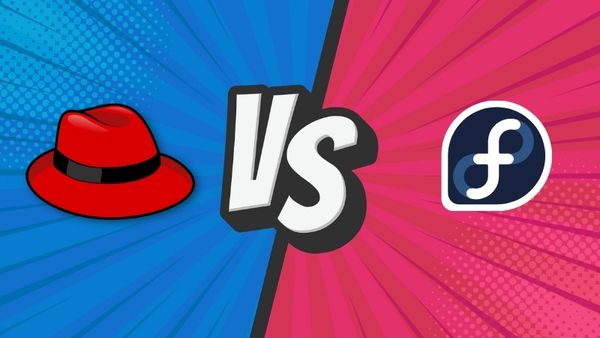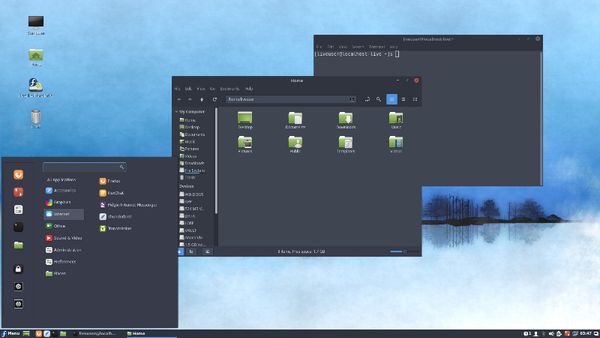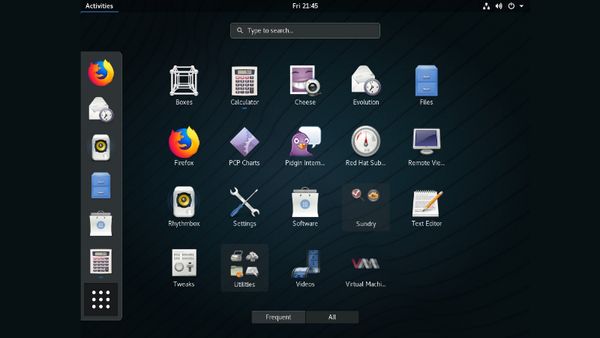- Fedora Vs Red Hat: Which Linux Distro Should You Use and Why?
- Difference Between Fedora And RHEL
- Community Version vs Enterprise Version
- Free vs Paid
- Upstream vs Downstream
- Release Cycle
- Cutting-edge Linux Distribution
- File System
- Variants Available
- Similarities Between Fedora And RHEL
- Parent Company
- Open Source Product
- Desktop Environment And Init System
- RPM-based Distribution
- Fedora Or Red Hat: Which One Should You Choose?
Fedora Vs Red Hat: Which Linux Distro Should You Use and Why?
If you’re in a situation to choose between Fedora and Red Hat Enterprise Linux (RHEL) distributions, the article will help to make a good decision.
Fedora and Red Hat. Both Linux distributions belong to the same organization, both use RPM package manager and both provide desktop and server editions. Both Linux distributions have a greater impact on the operating system world. This is why it is easier to get confused between the two similar distributions. In this article, I will discuss the similarities and difference between Red Hat and Fedora. This will help you if you want to choose between the two or simply want to understand the concept of having two distributions from the same organization.
Difference Between Fedora And RHEL
Let’s talk about the difference between the two distributions first.
Community Version vs Enterprise Version
Back in 1995, Red Hat Linux had its first non-beta release, which was sold as a boxed product. It was also called Red Hat Commercial Linux. Later in 2003, Red Hat turned Red Hat Linux into a Red Hat Enterprise Linux (RHEL) focussed completely on enterprise customers. Since then, Red Hat is an enterprise version of Linux distribution. What it means is that you have to subscribe and pay to use Red Hat as it is not available as a free OS. Even all software, bug fixes, and security support are available for only those who have an active Red Hat subscription. At the time when Red Hat Linux became RHEL, it also resulted in the foundation of the Fedora Project that takes care of the development of Fedora Linux. Unlike Red Hat, Fedora is a community version of the Linux distribution that is available at free of cost for everyone including bug fixes and other services. Even though Red Hat sponsors the Fedora Project, Fedora Linux is primarily maintained by an independent open source community.
Free vs Paid
Well, you will find the majority of Linux distributions are available to download free of cost. Fedora Linux is also one such distro, whose desktop, server, all other editions, and spins are freely available to download. There are still Linux distros for which you have to pay. Red Hat Enterprise Linux is one such popular Linux-based operating system that comes at cost of money. You may get Red Hat for free by registering for its developer program. If you want the entire RHEL developer suite, it costs $99 per year. You have to pay more than $100 to purchase other RHEL versions for servers, virtual datacenters, and desktops. This comes with Red Hat customer support.
Upstream vs Downstream
Fedora is upstream of RHEL and RHEL is downstream of Fedora. This means when a new version of Fedora releases with new features and changes, Red Hat makes use of Fedora source code to include the desired features in its next release. Of course, Red Hat also test the pulled code before merging into its own codebase for RHEL. In another way, Fedora Linux acts as a testing ground for Red Hat to first check and then incorporate features into the RHEL system.
Release Cycle
For delivering the regular updates to all components of the OS, both RHEL and Fedora follow a standard fixed-point release model. Fedora has a new version release approximately every six months (mostly in April and October) that comes with maintenance support for up to 13 months. Red Hat releases a new point version of a particular series every year and a major version after approximately 5 years. Each major release of Red Hat goes through four lifecycle phases that range from 5 years of support to 10 years with Extended Life Phase using add-on subscriptions.
Cutting-edge Linux Distribution
When it comes to innovation and new technologies, Fedora takes a complete edge over the RHEL. Even though Fedora does not follow the rolling release model, it is the distribution known for offering bleeding-edge technology early on. This is because Fedora regularly updates the packages to their latest version to provide an up-to-date OS after every six months. If you know, GNOME 40 is the latest version of the GNOME desktop environment that arrived last month. And the latest stable version 34 of Fedora does include it, while the latest stable version 8.3 of RHEL still comes with GNOME 3.32.
File System
Do you put the organization and retrieval of data on your system at a high priority in choosing an operating system? If so, you should know about XFS and BTRFS file system before deciding between Red Hat and Fedora. It was in 2014 when RHEL 7.0 replaced EXT4 with XFS as its default file system. Since then, Red Hat has an XFS 64-bit journaling file system in every version by default. Though Fedora is upstream to Red Hat, Fedora continued with EXT4 until last year when Fedora 33 introduced Btrfs as the default file system. Interestingly, Red Hat had included Btrfs as a “technology preview” at the initial release of RHEL 6. Later on, Red Hat dropped the plan to use Btrfs and hence removed it completely from RHEL 8 and future major release in 2019.
Variants Available
Compared to Fedora, Red Hat has very limited number of editions. It is mainly available for desktops, servers, academics, developers, virtual servers, and IBM Power Little Endian. While Fedora along with official editions for desktop, server, and IoT, provides an immutable desktop Silverblue and a container-focused Fedora CoreOS. Not just that, but Fedora also has purpose-specific custom variants called Fedora Labs. Each ISO packs a set of software packages for professionals, neuroscience, designers, gamers, musicians, students, and scientists. Want different desktop environments in Fedora? you can also check for the official Fedora Spins that comes pre-configured with several desktop environments such as KDE, Xfce, LXQT, LXDE, Cinnamon, and i3 tiling window manager. Furthermore, if you want to get your hands on new software before it lands in stable Fedora, Fedora Rawhide is yet another edition based on the rolling release model.
Similarities Between Fedora And RHEL
Parent Company
Red Hat Inc. is the common company that backs both Fedora project and RHEL in terms of both development and financial. Even Red Hat sponsors the Fedora Project financially, Fedora also has its own council that supervises the development without Red Hat intervention.
Open Source Product
Before you think that Red Hat charges money then how it can be an open-source product, I would suggest reading our article that breaks down everything about FOSS and Open Source. Being an open source software does not mean you can get it freely, sometimes it can cost money. Red Hat is one of the open source companies that have built a business in it. Both Fedora and Red Hat is an open source operating system. All the Fedora package sources are available here and already packaged software here. However, in the case of Red Hat, the source code is also freely available for anyone. But unlike Fedora, you need to pay for using the runnable code or else you are free to build on your own. What you pay to Red Hat subscription is actually for the system maintenance and technical support.
Desktop Environment And Init System
The flagship desktop edition of Fedora and Red Hat ships GNOME graphical interface. So, if you’re already familiar with GNOME, starting with any of the distributions won’t be of much trouble. Are you one of the few people who hate SystemD init system? If so, then none of Fedora and Red Hat is an OS for you as both supports and uses SystemD by default. Anyhow if you wishes to replace it with other init system like Runit or OpenRC, it’s not impossible but I would say it won’t be a best idea.
RPM-based Distribution
If you’re already well-versed with handling the rpm packages using YUM, RPM, or DNF command-line utility, kudos! you can count in both RPM-based distributions. By default, Red Hat uses RPM (Red Hat Package Manager) for installing, updating, removing, and managing RPM software packages. Fedora used YUM (Yellowdog Updater Modified) until Fedora 21 in 2015. Since Fedora 22, it now uses DNF (Dandified Yum) in place of YUM as the default package manager.
Fedora Or Red Hat: Which One Should You Choose?
Frankly, it really depends on who you’re and why do you want to use it. If you’re a beginner, developer, or a normal user who wants it for productivity or to learn about Linux, Fedora can be a good choice. It will help you to set up the system easily, experiment, save money, and also become a part of the Fedora Project. Let me remind you that Linux creator Linus Torvalds uses Fedora Linux on his main workstation. However, it definitely does not mean you should also use Fedora. If you happen to be an enterprise, you may rethink choosing it considering Fedora’s support lifecycle that reaches end of life in a year. And if you’re not a fan of rapid changes in every new version, you may dislike cutting-edge Fedora for your server and business needs. With enterprise version Red Hat, you get high stability, security, and quality of support from expert Red Hat engineers for your large enterprise. So, are you willing to upgrade your server every year and get free community support or purchase a subscription to get more than 5 years of lifecycle and expert technical support? The decision is yours.
The author of this community submission, Sarvottam Kumar, is a software engineer by profession with interest and experience in Blockchain, Angular, React and Flutter. He loves to explore the nuts and bolts of Linux and share his findings with the world.


